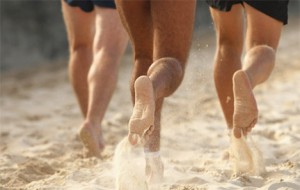By Candice A. Kepich, DPM –


Plantar fasciitis can affect both men and women of all ages, especially those who have any of the following risk factors:
- Age (most common between 40 – 60 years old)
- High arches, flatfeet or abnormal walking pattern
- Overweight or sudden weight gain (ie. pregnancy)
- Your feet roll in too much when you stand or walk (over-pronation)
- Wearing shoes which are poor fitting with little or no support or worn out (ie, flats, heels, sandals- especially flip flops). You should not be able to fold your shoe in half and it should have a thick cushioned sole.
- Tight calf muscles or Achilles tendon
- Jobs or activities which require standing, walking or running for long periods of time, especially on hard surfaces
- Running downhill or on uneven surfaces (ie, sand or beaches)
The common complaint associated with heel pain due to plantar fasciitis is stabbing, burning or aching pain on the bottom of the heel which is worse on the first step of the day out of bed or after periods of prolonged sitting or rest. The pain slowly worsens over time and can affect one foot or both and gets better as you “warm up” and gradually become more active. The pain may be worse standing in one place on hard surfaces, climbing stairs, or after intense exercise.
There is no one treatment for plantar fasciitis that works for everyone and the time it takes to get better depends on how long you have been in pain. Conservative treatments to try at home include rest, icing (especially by rolling the arch over a frozen bottle of water), stretching exercises and splints worn overnight to help loosen overtight muscles, and over the counter pain relievers like ibuprofen (Motrin and Advil) or naproxen (Aleve). Acetaminophen (Tylenol) may help reduce pain but does not decrease swelling and inflammation, which is a key factor in the pain causing plantar fasciitis. You should also wear shoes with good support and avoid going barefoot. Over the counter shoe inserts are commonly tried but the support they offer is highly variable depending on the material they are made of. Heel cups are also popular and may feel better initially from the added cushion they provide but rarely work long term because they don’t improve your foot’s arch support.
If your pain continues despite all best efforts you should see a podiatrist, who is a doctor that is specially trained in the foot and ankle. It is very important to seek medical advice before the heel pain causes damage or even worse, reveals other conditions, which may be the true cause of the pain. Your doctor can take x-rays to check for a break in the bone, a spur and better evaluate the structure of your foot. In some instances when pain continues despite proper treatment, a more detailed test like an ultrasound or an MRI may be necessary to look for a tear or rupture of the fascia. Your podiatrist can also give you a cortisone injection to help resolve the pain faster, send you for physical therapy or cast you for a pair of custom orthotics for long-term relief and proper control of your feet. With proper treatment you should see results within a few weeks and complete relief in 6-9 months. Greater than 90% of people improve with conservative treatment alone and few require surgery to release the plantar fascia. Seeing your podiatrist is the best way to keep your feet healthy, happy and pain free!
Cortez Foot & Ankle Specialists
www.cortezfootandankle.com
Candice A. Kepich, DPM
Dr. Candice Kepich earned her DPM from Temple University School of Podiatric Medicine in 2008. She then completed a three-year Podiatric Medi-
cal and Surgical Residency at Mercy Suburban Hospital in East Norriton, Pennsylvania. Her residency provided Dr. Kepich with specialized training in reconstructive foot and ankle surgery, diabetic foot and wound care and limb salvage.
Dr. Kepich has received advanced training from the Synthes AO Foundation in Foot and Ankle Surgery. She also attended a course through the American College of Foot and Ankle Surgeons in Foot and Ankle Arthroscopy. She is Board Qualified in foot surgery and reconstructive rearfoot and ankle surgery by the American Board of Podiatric Surgery. She is a proud member of the American Podiatric Medical Association, American College of Foot and Ankle Surgeons and Florida Podiatric Medical Association. She has hospital affiliations with Lakewood Ranch Medical Center, Lakewood Ranch, Blake Medical Center, Bradenton and Manatee Memorial Hospital, Bradenton. Dr. Kepich joined Cortez Foot and Ankle in August of 2011.
Dr. Kepich integrates quality of care with communication and compassion and emphasizes patient education. Her goal is to provide the highest quality foot and ankle care to the residents of Manatee and Sarasota counties. During Dr. Kepich’s free time, she enjoys swimming, biking, gardening, fitness, relaxing at the beach and spending time with her husband and 2 cats.
Call To Schedule Your Appointment Today!
941-758-8818
 Southwest Florida's Health and Wellness Magazine Health and Wellness Articles
Southwest Florida's Health and Wellness Magazine Health and Wellness Articles

